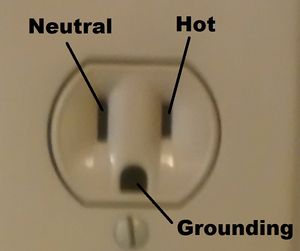Voltage

Voltage is often used as a shorthand term for voltage difference, which is another name for potential difference. Voltage measures the energy that a charge will get if it moves between two points in space. The unit for voltage is the volt (V) and 1 Volt = 1 J/C.[2]
Outlets and batteries both have voltages that are associated with them. In fact, whenever electricity is delivered over any distance, there is a voltage, (also known as potential difference), between the start and end points. When a voltage is applied, it is energetically preferable for an electric charge to move towards the point of lowest voltage in the wire; that's a fancy way of saying that a positive electric charge gains energy when going from a point of high voltage to a point of low voltage. A negative electric charge would get energy from going in the other direction.
The greater the voltage, the greater the energy gain from moving between the two points. In addition, the greater the charge that travels through a voltage, the greater the kinetic energy gained by the charge. The equation that models this is:
One single point does not have a voltage, since voltage is defined as the energy difference between two points. Voltage always depends on some reference point that is defined to be 0 V. For convenience, the Earth is almost always defined to be 0 V (in physics classes 0 V is often taken to be the potential at the point infinitely far away, but that isn't useful in electronics). Voltage generates the flow of electrons (electric current) through a circuit. The specific name for the source of energy that creates the voltage to make current flow is electromotive force. This relationship between voltage and current is given by Ohm's law.
An analogy is often helpful:
Gravitational potential energy is the energy that a ball stores while sitting on a table. The height times the acceleration due to gravity (g) gives the total energy that transforms into kinetic energy should the ball fall from that height. Electromotive force is whatever keeps picking the ball up and putting it back on the table (that's what drives the flow of balls falling off of the table).
Electrical energy is the energy released when a charge 'falls' through a potential difference (voltage). The voltage exists whether the charge is present or not.
In domestic applications
An electrical outlet in a house has 120 V (in Canada and the US) across the two holes. That voltage is always present and when an electrical load becomes part of the circuit (by plugging in an appliance, for example), that voltage makes current flow through the circuit.
Electric generators move magnets near coils of wires to create the voltages on the electrical grid.
DC generation creates voltages using the energy from light in photovoltaic cells, or the energy from chemical reactions, usually inside batteries, and even temperature differences by using thermocouples. To learn more about the physics of voltage, please see hyperphysics.
A 9V battery has a voltage of 9V. Double A, AAA, C, and D batteries all have voltages (potential differences) of 1.5 V.
Phet Simulation
The greater the voltage, the more current will flow through a circuit. The University of Colorado has graciously allowed us to use the following Phet simulation. Using the simulation below, investigate how increasing the voltage increases the current in a circuit:
For Further Reading
For further information please see the related pages below:
- Direct current
- Alternating current
- Electrical grid
- Energy for electricity by country
- Or explore a random page!

